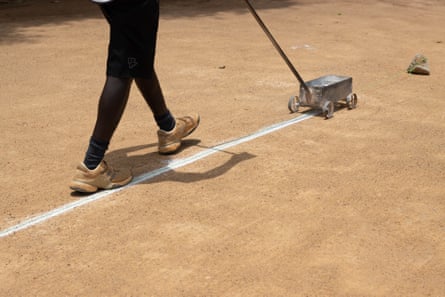The Daily Observer London Desk: Reporter- Sarah Marshal
My sport is not a well-known one in Uganda. Tennis requires equipment and a well-maintained court with a flat surface – all expensive things. It is a foreign game, brought here by the British colonialists, and the exclusive courts were constructed and used by only the wealthiest in society.
There were courts at Makerere University and at the Kampala Club. One was also built beside the cricket oval at Lugogo, and it’s still there. But the sport remained largely the elite preserve of foreigners, at first the whites and later, increasingly, Asians.




- Court maintenance, supply of balls and restringing of rackets must all be done before play can begin. Here, David Oringa serves in a match at Lugogo tennis complex in Kampala, and Charles Wanyama umpires a national championship clash between Simon Ayera, left, and Godfrey Ocen
After independence in 1962, the cream of the newly minted political class found a fondness for tennis, which remained a rich person’s sport throughout the 70s and 80s. Many of the courts were sold off and the land developed.
Now a small but lively tennis scene has emerged in Kampala, Uganda’s capital, as equipment becomes more widely available, more durable and less costly. Tennis is no longer restricted to the elites although it remains a distinctly middle-class sport. Public courts are few and far between, and there’s little public or media attention.

A new community of tennis enthusiasts is now working to change this, running sports camps for children during school holidays and encouraging their participation as much as possible. By trading secondhand equipment and maintaining the courts as best they can using locally made equipment, a small group of dedicated players is hoping to ignite a passion for tennis in Kampala.
Most courts in Uganda are made of clay, mainly because they are cheaper than hard courts to construct. But clay courts require brushing, watering, pressing and marking on a daily basis. Sometimes materials for this are improvised – lime or ash is used to draw the lines, a string helps demarcate the lines and a stone holds down the string.
Tennis balls are among the most expensive pieces of equipment; a tin of three costs 40,000 Ugandan shillings (£9). Academies struggle to source enough tennis balls for the rising number of players, and usually make do with donations from well-wishers and used balls from professional players.




- Veteran coach John Oduke, and some of the youngsters he has inspired: Florence Nabulime (top right), Patricia Nakawunde (bottom left) and new champion Winnie Birungi
John Oduke, 64 is one of few Ugandans lucky enough to learn the sport at an early age in the 1960s. He began as a ball boy and rose, without the benefit of a coach, to be one of the top players in the country, representing Uganda in the 1998 Davis Cup. He is now the national coach of the Ugandan tennis team.
Among those hoping to emulate him is eight-year-old Florence Nabulime, daughter of tennis coach Charles Ssenyange. She says: “Dad inspired me into the sport. I love tennis because it also helps me make new friends.” Patricia Nakawunde, also eight, is equally keen, and travels 32km to attend training in Kampala from her village near Matuga. Both are following in the footsteps of Winnie Birungi, 19, who won the national championships last summer.

My childhood home was close to tennis courts. On my way to school, I would always watch the players with admiration. My house had previously belonged to an Asian family, and they had left behind a wooden racket which sparked my curiosity.
I first tried playing tennis in 2006 and I haven’t stopped since. I love the sport because of the attributes it promotes in players. Values such as discipline, trust and sacrifice help my mind as well as my body grow stronger.



